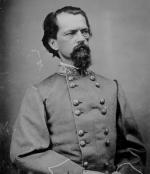![header=[Marker Text] body=[June 28, 1863, Confederate Gen. Gordon's brigade of Early's division followed this route through York to Wrightsville. Early's main force remained here until June 30, when it left to rejoin Lee's army.] sign](http://explorepahistory.com/kora/files/1/10/1-A-1F3-139-ExplorePAHistory-a0h2p8-a_450.jpg)
Mouse over for marker text
Name:
Gettysburg Campaign [General Gordon]
Region:
Hershey/Gettysburg/Dutch Country Region
County:
York
Marker Location:
PA 462 (old US 30), .3 mile west of PA 234, west of York
Dedication Date:
October 8, 1947
Behind the Marker
On the evening of June 27, 1863, Brigadier General John B. Gordon's brigade of six Georgia regiments encamped at the small village of Farmer's, located just south of the York Pike about ten miles east of York. Captain W. A. Tanner's four-gun battery, detached from the division's artillery battalion, accompanied Gordon's command. His division commander, Major General Jubal A. Early, halted the other three brigades of the division a few miles north, on the road from East Berlin to Dover. That evening, Early rode south to consult with Gordon about the advance on York, which the Confederates believed was undefended. "If that proves true," said Early, "you will pass on through and move rapidly to the river to secure both ends of the Wrightsville-Columbia bridge."
Later that evening, Arthur Farquhar left York and made his way to the Rebel picket line, where he asked to see the enemy commander. Ushered into Gordon's presence, Farquhar announced that York was indeed free of Yankee soldiers. He asked Gordon's permission to go back to York to inform its citizens that the Rebels were coming. The general acquiesced but told Farquhar that city officials should visit him the next morning to confirm that there were no Yankee troops in York.
Early the next morning, Mayor George Small and a few citizens visited Gordon and asked that private property and civilians be respected. They were relieved when Gordon assured them that no harm would come to people who stayed out of their way. About 9:30 that morning, Colonel Clement A. Evans' 31st Georgia regiment marched into York and deployed across the city to maintain law and order. Stopping at the center square, the colonel ordered that the American flag flying over a nearby building be removed.
At ten o'clock, Gordon's remaining five regiments marched through York. As the general rode through the city, a young girl, about twelve years old, darted out from a crowd of onlookers and handed the general a bunch of roses. In the center of this bouquet Gordon found a folded piece of paper. Written in an obvious female hand, the note provided a detailed description of the Union troops and defenses at Wrightsville. Later the general would recall: "I carefully read and reread this strange note. It bore no signature and contained no assurance of sympathy for the Southern cause, but it was so terse and explicit in its terms as to compel my confidence."
Continuing its march through York Gordon's brigade, less Evans' regiment halted a few miles to the east on the Lancaster Pike. Coming in from the north, Early's other three brigades occupied York. Once these troops occupied the city, Gordon continued east toward Wrightsville, where he intended to seize the bridge across the Susquehanna River. The stage was set for one of the dramatic events of the Confederate high tide in Pennsylvania.
Wrightsville, where he intended to seize the bridge across the Susquehanna River. The stage was set for one of the dramatic events of the Confederate high tide in Pennsylvania.
Later that evening, Arthur Farquhar left York and made his way to the Rebel picket line, where he asked to see the enemy commander. Ushered into Gordon's presence, Farquhar announced that York was indeed free of Yankee soldiers. He asked Gordon's permission to go back to York to inform its citizens that the Rebels were coming. The general acquiesced but told Farquhar that city officials should visit him the next morning to confirm that there were no Yankee troops in York.
Early the next morning, Mayor George Small and a few citizens visited Gordon and asked that private property and civilians be respected. They were relieved when Gordon assured them that no harm would come to people who stayed out of their way. About 9:30 that morning, Colonel Clement A. Evans' 31st Georgia regiment marched into York and deployed across the city to maintain law and order. Stopping at the center square, the colonel ordered that the American flag flying over a nearby building be removed.
At ten o'clock, Gordon's remaining five regiments marched through York. As the general rode through the city, a young girl, about twelve years old, darted out from a crowd of onlookers and handed the general a bunch of roses. In the center of this bouquet Gordon found a folded piece of paper. Written in an obvious female hand, the note provided a detailed description of the Union troops and defenses at Wrightsville. Later the general would recall: "I carefully read and reread this strange note. It bore no signature and contained no assurance of sympathy for the Southern cause, but it was so terse and explicit in its terms as to compel my confidence."
Continuing its march through York Gordon's brigade, less Evans' regiment halted a few miles to the east on the Lancaster Pike. Coming in from the north, Early's other three brigades occupied York. Once these troops occupied the city, Gordon continued east toward






